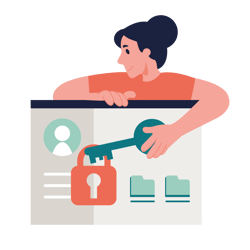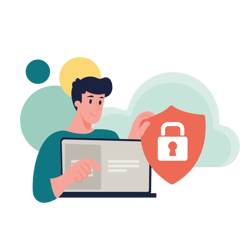8 tips for better online security
Cyber threats pose a persistent risk to both individuals and companies, and it can often be difficult to navigate the various online security practices. Therefore, we have put together 8 tips that can help you and your business to strengthen your online security.
1. Understand the importance of IAM
IAM stands for Identity and Access Management and is about controlling and monitoring who has access to what. IAM is about more than just assigning access rights; it also includes ongoing monitoring and auditing of these rights to ensure they remain appropriate and secure. By understanding and prioritizing IAM, you and your business can not only prevent unauthorized access but also ensure that employees have the access they need to perform their work effectively.
→ Here you can read more about what IAM is and why it is important.
2. Switch to passwordless authentication
As we use more and more digital services, we need to juggle an increasing amount of passwords. It can quickly become challenging to keep track of them. Therefore, many choose to reuse passwords or create simple codes that are easy to remember. But this makes passwords vulnerable.
With passwordless authentication, you don't have to keep track of an arsenal of various and complex passwords. Instead, access is based on facial recognition, authentication apps, or fingerprints. In this way, the login process becomes faster, easier, and more secure.
→ Here you can read more about 5 advantages of logging in without a password.
3. Two-factor authentication(2FA)
2FA has become a standard method for many online services to enhance the security of user accounts. By combining something you know (such as your password) with something you have (such as a one-time code sent to your mobile), 2FA significantly reduces the risk of unauthorized access. Even if a cybercriminal gets hold of your password, they would still need to access your second authentication method to log in. Therefore, it's essential to activate 2FA on all services that offer it, to better protect your online information.
4. Ongoing employee education
Human error is often the weak point in cybersecurity. Even with the most advanced technical protective measures, a single employee who clicks on a malicious link or unintentionally shares sensitive information can jeopardize the entire company's security. It is therefore crucial that all employees — from management to the newest hires — understand digital threats and how to spot and avoid them. Regular workshops and training sessions can thus help keep everyone's knowledge up to date.
→ Read more in the article here, which delves into why every employee poses a security threat.
5. Update regularly
Cybercriminals are always searching for weaknesses in systems and software and exploit them to steal data. One of the most effective ways to protect oneself is by regularly updating one’s programs. When developers discover security breaches in their software, they often release patches or updates to fix them. If you don’t install these updates in time, it’s like rolling out the red carpet for hackers. Therefore, ensure that your systems are set to automatically check for and install updates.

6. Evaluate access rights
Granting all employees full access to all systems increases security risks. Employees should only have access to what they actually need for their jobs. With IAM, it’s possible to regularly review and adjust these access rights — especially when employees change positions or leave the company. This ensures more targeted access management and reduces potential threats.
→ 8 things you should consider when acquiring an IAM solution.
7. Use secure connections
It's easy to be tempted to connect to public Wi-Fi, especially while traveling or working outside the office. But it comes with a risk. Public Wi-Fi networks are often not secure, making it easy for malicious actors to intercept traffic and capture sensitive data, such as login information or credit card details. Therefore, a good rule of thumb is always to use your mobile hotspot instead when you are outside of home and office.
Another tool to achieve a secure connection is to use a VPN, which encrypts your internet connection. With a VPN, your traffic goes through a secure server before reaching the internet, making it significantly more difficult for unauthorized parties to snatch your data.
8. Conduct a risk assessment
The vast majority of cyber attacks are caused by compromised accounts. Therefore, a risk assessment linked to Identity and Access Management (IAM) is an important basis for protecting your business. By assessing and identifying potential vulnerabilities and the associated consequences, it is possible to implement tailored security measures that can effectively counteract the threats.
A risk assessment should include a thorough review of user rights, access policies, and authentication processes. Additionally, you should regularly reassess IAM routines to ensure they keep pace with changes in your business and the surrounding threat landscape. With a continuous approach to risk minimization, it helps ensure that your company's data and activities remain protected, even as new threats and challenges arise.
→ Read more about risk assessments, and how Cloudworks can assist your business.
Schedule a meeting
If you're interested in discussing the possibilities of an IAM solution for your company, feel free to schedule a meeting with our Costumer Success Manager, Ivar Lyse.
→ Click here to view available times in Ivar Lyse's calendar










